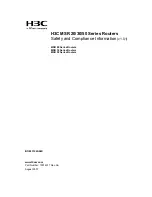
AirPro
DWL-6000AP
Standards - Based Technology
The versatile DWL-6000AP Multimode Wireless Access Point integrates both 802.11a and 802.11b
standards.
The IEEE
802.11a
standard designates that devices operate at an optimal data rate of 54 Megabits
per second. This means you will be able to transfer large files quickly or even watch a movie in MPEG
format over your network without noticeable delays. This technology works by transmitting high-speed
digital data over a radio wave utilizing
OFDM
(
O
rthogonal
F
requency
D
ivision
M
ultiplexing) technology.
OFDM
works by splitting the radio signal into multiple smaller sub-signals that are then transmitted
simultaneously at different frequencies to the receiver.
OFDM
reduces the amount of
crosstalk
(interference) in signal transmissions. D-Link
AirPro
products will automatically sense the best
possible connection speed to ensure the greatest speed and range possible with the technology.
The IEEE
802.11b
standard-based technology assures that the DWL-6000AP is interoperable with
existing compatible 2.4GHz wireless technology with data transfer speeds of up to 22Mbps (as in the
D-Link
Air
Plus Family of Wireless devices,) as well as standard 802.11b technology (as in the D-Link
Air
Family of Wireless devices), with speeds of up to 11Mbps. D-Link
Air
Plus products will
automatically sense the best possible connection speed to ensure the greatest speed and range
possible with the technology.
Installation Considerations
Designed to go up to 1,312 feet (400 meters) outdoors and up to 328 feet (100 meters) indoors, D-
Link
Air
Pro DWL-6000AP lets you access your network, using a wireless connection, from virtually
anywhere. Keep in mind, however, that the number, thickness and location of walls, ceilings or other
objects that the wireless signals must pass through may limit the range. Typical ranges vary
depending on the types of materials and background RF (radio frequency) noise in your home or
business. The key to maximizing wireless range is to follow these basic guidelines:
1.
Keep the number of walls and ceilings to a minimum:
The signal emitted from Wireless LAN devices can penetrate through ceilings and walls.
However, each wall or ceiling can reduce the range Wireless LAN devices from 1 to 30M.
Position your Access Points, Residential Gateways, and Computers so that the number of
walls or ceilings obstructing the signal path is minimized.
2.
Consider the direct line between Access Points, Residential Gateways, and Computers:
A wall that is 0.5 meters thick, at a 45-degree angle appears to be almost 1 meter thick. At a
2-degree angle, it is over 14 meters thick. Be careful to position the Access Point and
Adapters so the signal can travel straight through (90º angle) a wall or ceiling for better
reception.
3.
Building Materials make a difference:
Buildings constructed using metal framing or doors
can reduce effective range of the device. Whenever possible, position WLAN devices so that
their signal can pass through drywall or open doorways, avoid positioning them so that their
signal must pass through metallic materials.
4.
Position the antennas for best reception.
Keep your product away (at least 1-2 meters)
from electrical devices:
Position WLAN devices away from electrical devices that generate RF
noise such as microwave ovens, monitors, electric motors, etc.
If you experience low or no signal strength in areas of your home that you wish to access, consider
positioning the Access Point in a location directly between the computers with wireless adapters.
Additional Access Points can be connected to provide better coverage in rooms where the signal does
not appear as strong as desired.
5
Summary of Contents for AirPro DWL-6000AP
Page 72: ...AirPro DWL 6000AP 70 ...








































